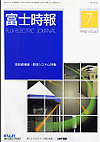FUJI ELECTRIC JOURNAL Vol.67-No.7 (Jul/1994)
 |
Radiation Measurement Equipment and Control System |
Present Status and Prospects for Radiation Measurement Equipment
Kiyoji Yamaguchi, Toyoshi Kusudo
Classifying radiation measurement equipment into monitors, systems, and radiation instruments, this paper describes trends of their demand and technology. For the present, few nuclear power plants are newly built or extended; however, there are demands for renewals or related to nuclear fuel reprocessing facilities, so the total of demands is on the slight increase. With regard to the technical trend, systematization associated with a computer will be pushed further, and also individual instruments will be improved towards advanced and intelligent functions.
Radiation Sensors
Ryuuzi Hanafusa, Takeshi Ishikura
From among radiation sensors classified by detection principles, this paper mainly introduces distinctive solid-state detectors and plastics scintillation ones. Detailed are the configuration, operation principle, and characteristics of solid-state detectors for a high-temperature area monitor usable up to 60℃ and for a dust monitor with a sensitive area of 2,000mm2 and of a plastics scintillation detector for a contamination monitor with a sensitive area of 625×520mm.
Personal Exposure Control System
Ken'ichi Tanabe, Michio Akashi
Nuclear power stations are under strict radiation control. Exposure control for nuclear workers is the most important operation, and so carefully thought out measures are taken. This paper introduces Fuji Electric's personal exposure control system that meets strict exposure control and rationalizes control operations. The system has a merit that it can provide required information in an optimum form using the interconnection of a super minicomputer and exposure control facilities and realizes sophisticated exposure control operations.
Radioactive Surface Contamination Monitors
Kei Aoyama, Atsushi Minagoshi, Toru Hasegawa
To reduce radiation exposure and prevent contamination from spreading, each nuclear power plant has established a radiation controlled area. People and articles out of the controlled area are checked for the surface contamination of radioactive materials with surface contamination monitors. Fuji Electric has repeatedly improved these monitors on the basis of user's needs. This paper outlines typical of a surface contamination monitor, a personal surface contamination monitor, an article surface contamination monitor and a laundry monitor, and the whole-body counter of an internal contamination monitor.
Radioactive Waste Control System
Etsuo Kono, Takamichi Higashitate, Michito Watanabe
This paper describes drum inspection equipment and a gate monitor concerning the carrying out and transport of low-level radioactive waste drums. The drum inspection equipment rapidly measures surface density by wiping all the drum surface with a cloth, surface dose equivalent rate by scanning detectors, and radioactive concentration in the drum with a fast, high-purity Ge detector and a plastic scintillator. The gate monitor can rapidly measure surface and 1-meter dose equivalent rate around a truck loaded with drums without being disturbed by ship radar even in severe outdoor temperatures or snowfall conditions.
Radiation Monitoring System Around Nuclear Power Plants
Toshiaki Fujimoto, Katsumi Yasutomo, Takashi Hanafusa
The establishment of a nuclear power plant requires measuring the air gamma dose rate to grasp conditions of the plant periphery, followed by radiation monitoring over a wide area around the plant. This paper introduces the configuration and data processing of a radiation monitoring system for the nuclear fuel reprocessing plant of Japan Nuclear Fuel Limited which was supplied by Fuji Electric and put in operation in April 1994.
Radiation Monitoring System in Nuclear Power Plants
Zenjiro Suzuki, Tsuyoshi Sakamaki, Mitsuhiro Imai
To reduce radiation exposure, nuclear power plants are equipped with area monitors and dust monitors, which provide exact information on working environment to take a proper protection against radiation exposure. Fuji Electric supplied numbers of these radiation monitors and recently has newly developed an area and dust monitors using a solid-state detector to meet needs for small-sized, reliable, high-sensitivity devices. Particularly the multipoint dust monitor which has functions of real-time processing, continuous monitoring, and predictive processing, fully satisfies needs for sophistication radiation control.
Radiation Control Systems
Nobuyoshi Takeuchi, Tamio Momose
In radiation handling facilities such as nuclear power plants, radiation control operations were formerly done by human systems using radiation measurement instruments. However by linking these instruments with a computer and building integrated radiation control systems, control operations are made labor-saving, rational, and exact. This paper describes radiation control systems supplied by Fuji Electric, particularly from the standpoint of the radiation control computer, the features of functions substituting human operations, entrance control for the radiation-controlled area, and output of data forms.
Radiation Monitoring System Applicable to a Nuclear Fusion Experimental Site
Haruo Obayashi, Jun'ichi Kodaira, Kiyoshi Matsuno
An area monitoring network system has been developed for application to LHD (Large Helical Device) fusion plasma experiment. When a rapid increase is noticed in signals from a sensor during a short time span, a burst-like event is identified by means of the burst-detecting circuit installed in the scaler and the fine structure of the signal evolution is recorded in a time-profile mode. Once a burst is noticed by any of the sensors, the whole system is turned into a burst analyzing status. Unless a burst-like event is encountered, the system remains in the background counting status.

